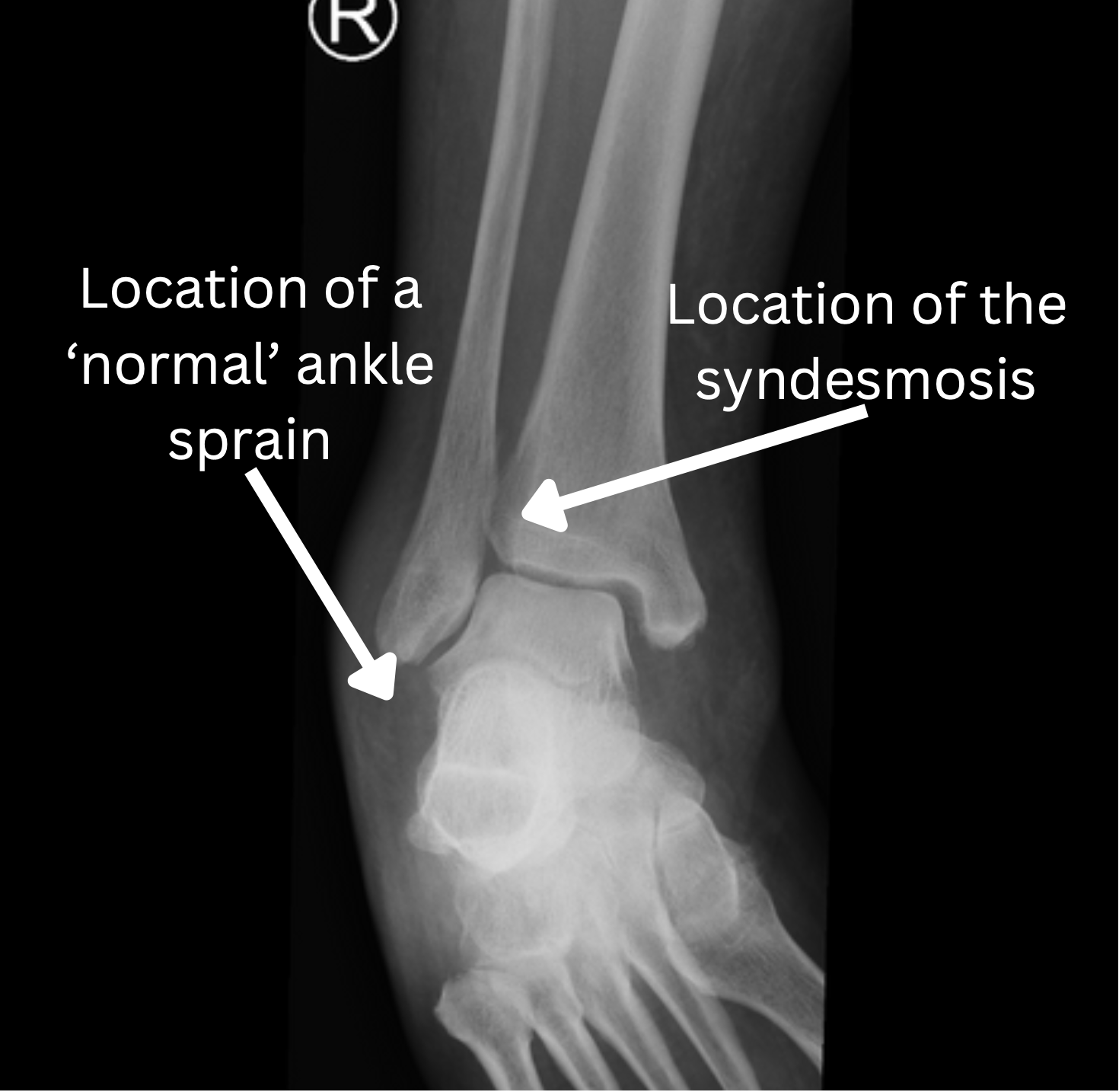Syndesmosis Injuries
What are Syndesmosis Injuries?
The syndesmosis is a key stabiliser of the ankle joint. It is the strong group of ligaments between the tibia and fibula at the ankle joint. The syndesmosis can be injured by an impact/twisting injury to the ankle. It can occur in conjunction with ankle fractures (see
Ankle Fractures). It is sometimes called a ‘high ankle sprain’ and is much less common than a normal ankle sprain.


Impact of Syndesmosis Injuries on Anatomy and Health
The syndesmosis joint is crucial for maintaining the alignment of the tibia and fibula during movement. When injured, this joint becomes unstable, leading to:
- Pain and Swelling: In the upper ankle area, making it difficult to walk or bear weight.
- Decreased Mobility: Affected individuals may struggle with activities that require ankle stability, such as running or jumping.
- Potential Complications: If untreated, syndesmosis injuries can lead to chronic instability, arthritis, or long-term pain.
Risk Factors for Syndesmosis Injuries
Syndesmosis injuries often occur in people who engage in high-impact or contact sports. Those most at risk include:
- Athletes: Particularly those involved in football, soccer, basketball, or rugby, where twisting or impact injuries are common.
- Skiers and Snowboarders: Due to the rigid boots that lock the lower leg while allowing the upper body to twist.
- Workers in Physically Demanding Jobs: Requiring frequent climbing, jumping, or sudden pivoting.
- Trauma: Syndesmosis injuries often occur with ankle fractures
Causes of Syndesmosis Injuries
Syndesmosis injuries are usually caused by external forces or sudden twisting movements that stress the ligaments connecting the tibia and fibula. Common causes include:
- Rotational Forces: A foot twisting outward relative to the leg, such as when a soccer player changes direction rapidly.
- Direct Trauma: A blow to the lower leg or ankle during contact sports or accidents.
- Overextension of the Ankle: This can occur during a misstep on uneven ground or when landing awkwardly from a jump.
- Improper Footwear or Support: Shoes not adequately supporting the ankle can contribute to ligament strain.
Symptoms of a Syndesmosis Injury
Syndesmosis injuries can range from a minor sprain of a ligament to a life-changing fracture dislocation of the ankle joint. If the syndesmosis is injured with an ankle fracture, it is usually too painful to walk on. If the syndesmosis is injured in isolation, most commonly after a fall, the following symptoms are:
- Pain and/or swelling over the area above the front part of the ankle joint
- Pain with walking/running/sport
- An ‘ankle sprain’ that does not improve over several weeks of treatment
Prevention of Syndesmosis Injuries
While some injuries are unavoidable, especially in high-risk activities, several strategies can minimise the risk of syndesmosis injuries:
- Strengthening Exercises: Focus on strengthening the muscles around the ankle and lower leg to improve joint stability.
- Proper Footwear: Wear supportive shoes appropriate for your activity to reduce undue stress on the ankle joint.
- Improve Technique: For athletes, working on proper form and avoiding risky movements can significantly reduce strain on the syndesmosis joint.
Types of Syndesmosis Injuries
Syndesmosis injuries can vary in severity and are typically classified into three types:
- Mild Injury (Grade I):
- Partial damage to the ligaments with minimal instability.
- Often referred to as a sprain.
- Symptoms include mild pain and swelling, with the ability to bear weight.
- Moderate Injury (Grade II):
- Partial tearing of the syndesmotic ligaments, leading to noticeable instability.
- Symptoms include moderate pain, swelling, and difficulty walking.
- Severe Injury (Grade III):
- Complete rupture of the ligaments, often accompanied by injury to surrounding structures such as the interosseous membrane.
- Significant pain, swelling, and inability to bear weight.
- Usually, it requires surgical intervention.
Stages of Syndesmosis Injuries
Syndesmosis injuries progress through stages depending on their severity and the healing process:
- Acute Stage (0-7 Days): Marked by pain, swelling, and inflammation.
- Subacute Stage (1-4 Weeks): Healing begins with reduced inflammation; tissue ligaments never heal back to their preinjury state (even with surgery), but with fibrous tissue forms to act as the syndesmosis
- Chronic Stage (4+ Weeks): If untreated or poorly managed, the injury may lead to chronic pain, instability, and reduced ankle function. In severe cases, arthritis or ankle joint deformity may develop.
Diagnosis of a Syndesmosis Injury
Syndesmosis injuries usually occur after an injury. Diagnosis involves taking a history, examining the foot, and getting X-rays.
Isolated syndesmosis injuries may have normal X-rays, as the ligaments are not visible. Weight-bearing X-rays may reveal the instability, and comparing it to the ‘normal’ foot is often helpful. In more severe injuries, X-rays can show associated fractures and displacement of the bones. Other injuries may need to be identified and treated.
If there is a clinical concern of a syndesmosis injury and the x-rays are normal, Dr Graff may request an MRI or a weight-bearing CT of both ankles (or both) to diagnose a syndesmosis injury.
Management and Treatment of Syndesmosis Injury
Management of syndesmosis injuries often requires surgery. Only ‘sprains’ of the syndesmosis ligament or injury of only part of the syndesmosis can be managed non operatively. Non-operative measures include:
- Rest
- Elevation
- Compression with a Tubigrip or bandage
- Ice
- Camboot and offloading
- Pain relief
- Blood thinners to prevent DVT
Most syndesmosis injuries require surgery to stabilise the joint between the tibia and fibula at the ankle level and prevent chronic pain and deformity (see Syndesmosis stabilisation surgery). Even after surgery, arthritis may develop in the ankle, which may feel different from before the injury. The surgery aims to stabilise the ankle, prevent deformity, and slow the progression of arthritis.
What if Syndesmosis Injuries are Untreated?
Failure to treat syndesmosis injuries can lead to serious complications, including:
- Chronic Pain and Instability
- Degenerative Joint Disease
- Loss of Mobility
- Deformity or Malalignment
- Long-Term Disability
Timely diagnosis and appropriate management are essential to ensuring full recovery from syndesmosis injuries and preventing long-term complications.
Useful Websites
